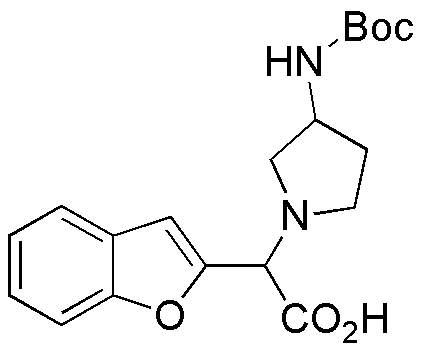Benzofuran-2-yl-(3-Boc-amino-pyrrolidin-1-yl)acetic acid is widely utilized in research focused on:
- Pharmaceutical Development: This compound serves as a key intermediate in the synthesis of novel pharmaceuticals, particularly in the development of drugs targeting neurological disorders.
- Biochemical Research: Researchers use it to study enzyme interactions and metabolic pathways, providing insights into drug metabolism and efficacy.
- Material Science: It is applied in creating advanced materials with specific properties, such as improved thermal stability and mechanical strength, beneficial for various industrial applications.
- Drug Delivery Systems: The compound is explored for its potential in formulating drug delivery systems, enhancing the bioavailability of therapeutic agents.
- Analytical Chemistry: It is utilized as a standard in analytical methods, aiding in the quantification of related compounds in complex mixtures, which is crucial for quality control in manufacturing.
General Information
Properties
Safety and Regulations
Applications
Benzofuran-2-yl-(3-Boc-amino-pyrrolidin-1-yl)acetic acid is widely utilized in research focused on:
- Pharmaceutical Development: This compound serves as a key intermediate in the synthesis of novel pharmaceuticals, particularly in the development of drugs targeting neurological disorders.
- Biochemical Research: Researchers use it to study enzyme interactions and metabolic pathways, providing insights into drug metabolism and efficacy.
- Material Science: It is applied in creating advanced materials with specific properties, such as improved thermal stability and mechanical strength, beneficial for various industrial applications.
- Drug Delivery Systems: The compound is explored for its potential in formulating drug delivery systems, enhancing the bioavailability of therapeutic agents.
- Analytical Chemistry: It is utilized as a standard in analytical methods, aiding in the quantification of related compounds in complex mixtures, which is crucial for quality control in manufacturing.
Documents
Safety Data Sheets (SDS)
The SDS provides comprehensive safety information on handling, storage, and disposal of the product.
Product Specification (PS)
The PS provides a comprehensive breakdown of the product’s properties, including chemical composition, physical state, purity, and storage requirements. It also details acceptable quality ranges and the product's intended applications.
Certificates of Analysis (COA)
Search for Certificates of Analysis (COA) by entering the products Lot Number. Lot and Batch Numbers can be found on a product’s label following the words ‘Lot’ or ‘Batch’.
*Catalog Number
*Lot Number
Certificates Of Origin (COO)
This COO confirms the country where the product was manufactured, and also details the materials and components used in it and whether it is derived from natural, synthetic, or other specific sources. This certificate may be required for customs, trade, and regulatory compliance.
*Catalog Number
*Lot Number
Safety Data Sheets (SDS)
The SDS provides comprehensive safety information on handling, storage, and disposal of the product.
DownloadProduct Specification (PS)
The PS provides a comprehensive breakdown of the product’s properties, including chemical composition, physical state, purity, and storage requirements. It also details acceptable quality ranges and the product's intended applications.
DownloadCertificates of Analysis (COA)
Search for Certificates of Analysis (COA) by entering the products Lot Number. Lot and Batch Numbers can be found on a product’s label following the words ‘Lot’ or ‘Batch’.
*Catalog Number
*Lot Number
Certificates Of Origin (COO)
This COO confirms the country where the product was manufactured, and also details the materials and components used in it and whether it is derived from natural, synthetic, or other specific sources. This certificate may be required for customs, trade, and regulatory compliance.


